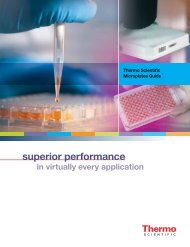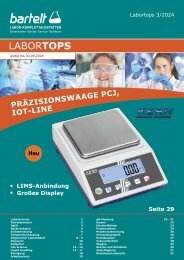PeloBiotech
You also want an ePaper? Increase the reach of your titles
YUMPU automatically turns print PDFs into web optimized ePapers that Google loves.
www.pelobiotech.com<br />
Nucleic Acid and Telomere Length Assays<br />
• Absolute and Relative Telomere Length Assay Kits: These kits are vital for measuring telomere length, which is linked<br />
to aging and various diseases, including cancer and cardiovascular conditions.<br />
• qRT-PCR Kits: These quantitative reverse transcription-polymerase chain reaction kits are used to analyze gene<br />
expression and are crucial for studying genes involved in cell cycle control and senescence.<br />
Metabolic and Redox Assays<br />
• Biopyrrin ELISA kit, Redox Assay: This assay quantifies biopyrrin, a marker for oxidative stress. It's applied to study<br />
oxidative damage in various biological systems.<br />
• Lactate Dehydrogenase (LDH) Assay: LDH is an enzyme released during cell damage. This assay helps assess cellular<br />
cytotoxicity and damage, often used in cytotoxicity studies and assessing cell health.<br />
• Creatinine, Urinary, ELISA Kit: Used to measure urinary creatinine levels, this assay aids in evaluating kidney function<br />
and diagnosing renal diseases.<br />
Cell Viability and Proliferation Assays<br />
• MTT and WST-1 Cell Viability & Proliferation Assays: These assays assess cell viability, metabolic activity, and<br />
proliferation. They are employed in drug screening, cytotoxicity testing, and assessing the effects of various<br />
compounds on cell health.<br />
TR-FRET<br />
Time-Resolved Fluorescence Resonance Energy Transfer (TR-FRET) is a powerful and versatile molecular assay technique<br />
used in biological research and drug discovery. TR-FRET allows scientists to study molecular interactions and events within<br />
cells or biochemical reactions with high sensitivity and precision. It is particularly valuable for measuring protein-protein<br />
interactions, receptor-ligand binding, and various other biomolecular processes.<br />
TR-FRET relies on the principles of fluorescence resonance energy transfer (FRET), in which energy is transferred from one<br />
fluorophore (the donor) to another (the acceptor) when they are in close proximity, typically within 10-100 angstroms. The<br />
key distinction in TR-FRET is the measurement of the time delay between excitation and emission, which eliminates shortlived<br />
background fluorescence and significantly enhances signal-to-noise ratios.<br />
To perform TR-FRET assays, researchers require specific reagents:<br />
• Donor and Acceptor Fluorophores: These are the fluorescent molecules that emit light when excited by an energy<br />
source. The donor fluorophore, typically a lanthanide chelate (e.g., Europium or Terbium), is excited by a pulsed<br />
73
















